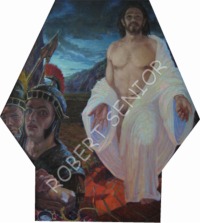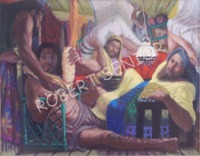The Resurrection
Resurrection, (The End Times)
(Commission)
Oil on canvas. 864 x 220cm.
This Resurrection painting has been inspired by themes and images from Isaiah, beginning with Isaiah 43:5, 6
This passage suggests the powerful sense of God's yearning to have his children back with him, suggesting that the end of the world and resurrection could be seen as a call to return home to him.
The basic composition shows the land twisting and buckling as resurrected humanity is drawn towards 'God's Mountain'. But this calamitous event has been transformed by Christ's resurrection into a joyful coming home. So, in the centre of the painting, angels proclaim the end of the world with music and dance. They dance around a cross with a shroud draped over it, to suggest Christ's pivotal empty tomb and resurrection.
One of Isaiah's themes is that of idolatry. I have interpreted idolatry as anything in our lives that we put before our relationship with God, whether it is money, power, relationships, talents, technology, or everyday objects and activities that take precedence over God in our lives and that discarding these idols finally leaves us free for a full relationship with God and readiness for Heaven.
On the understanding that we all have idols of one kind or another and that God meets us in these very weaknesses and uses them to draw us to him, the left hand part of the painting shows people letting go of their idols, which are being poured into builders' chutes and combine to form the grassed over promontory on which they are able to move towards Heaven. (The starting point for this was Isaiah 40: 3)
Isaiah talks about swords being beaten into ploughshares (Isaiah 2: 4). Tools of war being transformed into instruments of peace and life. This idea of transformation is important. Here we see a bath filled with weapons being carried towards the builders' chutes so that they can also be used to fill the promontory and so used to bring humanity to God.
Inspired by Isaiah 42: 16: where he speaks of the blind being led along unfamiliar ways, I have shown these weapons carried by blind soldiers and politicians, those who have used the weapons uncaringly and have been seduced by their power. They are led by a young boy who has also been blinded and lost a limb, a victim of warfare; raising the possibility, in my mind, that it might be the forgiveness of the boy and his willingness to help, that allows him to direct them towards the chutes and the chance to be freed of their idols.
Reading Isaiah 35:6 referring to the end times, I was struck by the possibility that our limitations and frailties could be transformed, encouraging me to think about the redemptive nature of suffering.
The prayerful living of her 'lameness' has allowed the woman with the 'zimmer' frame to leap across the chasm towards Heaven. The possibility that suffering can be offered up prayerfully for the welfare of others as well, is suggested by the chain of people who are being led towards Heaven by her.
I have taken Isaiah's image of Heaven as the 'Divine Banquet' to which all humanity is invited regardless of belief and shown people from other cultures and Faiths, as well as those with none, bringing exotic food for this Divine Banquet, beyond the right hand edge of the painting.



